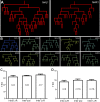The interscutularis muscle connectome
- PMID: 19209956
- PMCID: PMC2637925
- DOI: 10.1371/journal.pbio.1000032
The interscutularis muscle connectome
Erratum in
- PLoS Biol. 2009 Apr;7(4):e1000108
Abstract
The complete connectional map (connectome) of a neural circuit is essential for understanding its structure and function. Such maps have only been obtained in Caenorhabditis elegans. As an attempt at solving mammalian circuits, we reconstructed the connectomes of six interscutularis muscles from adult transgenic mice expressing fluorescent proteins in all motor axons. The reconstruction revealed several organizational principles of the neuromuscular circuit. First, the connectomes demonstrate the anatomical basis of the graded tensions in the size principle. Second, they reveal a robust quantitative relationship between axonal caliber, length, and synapse number. Third, they permit a direct comparison of the same neuron on the left and right sides of the same vertebrate animal, and reveal significant structural variations among such neurons, which contrast with the stereotypy of identified neurons in invertebrates. Finally, the wiring length of axons is often longer than necessary, contrary to the widely held view that neural wiring length should be minimized. These results show that mammalian muscle function is implemented with a variety of wiring diagrams that share certain global features but differ substantially in anatomical form. This variability may arise from the dominant role of synaptic competition in establishing the final circuit.
Conflict of interest statement
Competing interests. The authors have declared that no competing interests exist.
Figures







Comment in
-
In mammalian muscle, axonal wiring takes surprising paths.PLoS Biol. 2009 Feb;7(2):e1000050. doi: 10.1371/journal.pbio.1000050. Epub 2009 Feb 10. PLoS Biol. 2009. PMID: 20076726 Free PMC article. No abstract available.
References
-
- Ramon y Cajal S. In: Histology of the nervous system of man and vertebrates. Swanson N, Swanson LW, editors. New York: Oxford University Press; 1995. translators.
-
- White JG, Southgate E, Thomson JN, Brenner S. The structure of the nervous system of the nematode Caenorhabditis elegans . Phil Trans R Soc Lond B. 1986;314:1–340. - PubMed
-
- Traub RD, Contreras D, Cunningham MO, Murray H, LeBeau FE, et al. Single-column thalamocortical network model exhibiting gamma oscillations, sleep spindles, and epileptogenic bursts. J Neurophysiol. 2005;93:2194–2232. - PubMed
-
- Stepanyants A, Chklovskii DB. Neurogeometry and potential synaptic connectivity. Trends Neurosci. 2005;28:387–394. - PubMed
Publication types
MeSH terms
LinkOut - more resources
Full Text Sources
Other Literature Sources
Research Materials
Miscellaneous

